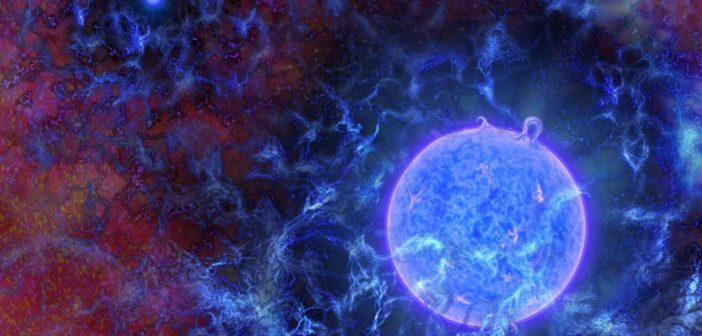In March of this year, a team of scientists announced an unprecedented radio detection: a signal from the first stars that formed in the universe. But the shape of this signal was not quite what we predicted — and theorists are now exploring what this means about the dawn of the universe.
A Cosmic Timeline
Our models of cosmic history tell us that after the Big Bang, the expanding universe consisted of a hot, opaque, ionized soup of gas. Perhaps 370,000 years later, recombination of these electrons and protons into neutral hydrogen atoms allowed light to travel freely through the universe — releasing the radiation we see today as the cosmic microwave background (CMB).At this stage in the universe’s history, there were not yet any stars or galaxies. With no sources of light, the universe continued on in the “cosmic dark ages” until redshifts of around z ~ 20, perhaps 100–200 million years after the Big Bang. By then, dark matter and gas had clumped into bound objects dense enough to ignite nuclear fusion — lighting up the first stars of our universe.

The shape of the best-fit EDGES signal is shown in the red dashed line; the corresponding signal from the authors’ model, in which the first stars are preferentially clustered in halos with mass above 10^9.4 solar masses, is shown with a blue line. The authors’ goal here is only to reproduce the sharpness of the drop on the low-frequency (right) side of the signal. [Adapted from Kaurov et al. 2018]
Fingerprint of the First Stars
These first stars are very distant and faint, so we don’t yet have the technology to detect them directly. But the ultraviolet radiation that these hot, young stars emitted would have heated the gas around them. According to models, this hot gas would then have absorbed some of the background radiation, causing a small dip in the intensity of the CMB at the radio wavelengths of 21 cm.
It is this dip — this subtle fingerprint of the first stars — that the EDGES team detected. But the shape of the signal wasn’t exactly as we were expecting: it’s both significantly deeper and has much sharper boundaries than predicted.
While many studies have since been published attempting to explain the surprising depth of the signal, a team of scientists led by Alexander Kaurov (Institute for Advanced Study) has instead opted to focus on the other puzzle: that of the signal’s sharp boundaries.

Inhomogeneous brightness temperature (left) and kinetic gas temperature (right) in the authors’ simulation, at six characteristic epochs. At z ~ 24 no sources have formed yet; around z ~ 22, evidence of the first sources is seen; by z ~ 19.7, many more are present. [Kaurov et al. 2018]
Seeing the Light
In a recent publication, Kaurov and collaborators examined possible scenarios that could lead to the sharpness seen on the low-frequency side of the EDGES signal. Physically, this feature tells us that as the first stars turned on, the universe was flooded with ultraviolet photons much more quickly than we expected.
Kaurov and collaborators show that this suddenness can be naturally explained if the sources of these photons — the first stars — were not distributed evenly throughout the universe’s structure, but were instead initially concentrated only in the rarest and most massive halos — those weighing more than a billion solar masses.
Early in the universe, the number of these rare halos grew rapidly. The authors use simulations to confirm that this sudden explosion of massive halos hosting bright, hot stars could have produced the flood of ultraviolet photons necessary to explain the EDGES signal.
If this scenario is correct, it has interesting implications for future observations. If the majority of the first stars were, indeed, located within the few rarest of halos, these halos would be especially bright. Though they’re scarce, these sources might be observable with the upcoming James Webb Space Telescope — providing us with another window into cosmic dawn.
Citation
“Implication of the Shape of the EDGES Signal for the 21 cm Power Spectrum,” Alexander A. Kaurov et al 2018 ApJL 864 L15. doi:10.3847/2041-8213/aada4c



13 Comments
Pingback: La forma del amanecer cósmico – Observatori Astronòmic
Pingback: Diciembre 2018 – Observatori Astronòmic
Pingback: La forma del amanecer cósmico « SEDA / LIADA - RedLIADA - Cursos LIADA - Cielo del Mes - Fenómenos Astronómicos - RELEA
Pingback: La forma del amanecer cósmico « Sección de Astrofísica de la LIADA
Pingback: The Roman Space Telescope’s Version of the Hubble Deep Field Will Cover a 100x Larger Area of the Sky – Madisens Science
Pingback: The Roman Space Telescope's Version of the Hubble Deep Field Will Cover a 100x Larger Area of the Sky - Universe Today »
Pingback: The Roman Space Telescope’s Version of the Hubble Deep Field Will Cover a 100x Larger Area of the Sky – Science
Pingback: The Roman Space Telescope’s Version of the Hubble Deep Field Will Cover a 100x Larger Area of the Sky - WeedHub
Pingback: The Roman Space Telescope’s Version of the Hubble Deep Field Will Cover a 100x Larger Area of the Sky – Universe Today – Zulnaz News
Pingback: The Roman Space Telescope’s Version of the Hubble Deep Field Will Cover a 100x Larger Area of the Sky – Low News
Pingback: The Roman Space Telescope's Version of the Hubble Deep Field Will Cover a 100x Larger Area of the Sky | | News Gossips.com
Pingback: The Roman Space Telescope’s Version of the Hubble Deep Field Will Cover a 100x Larger Area of the Sky – The News Wave Science
Pingback: The Roman Space Telescope’s Version of the Hubble Deep Field Will Cover a 100x Larger Area of the Sky – My Blog